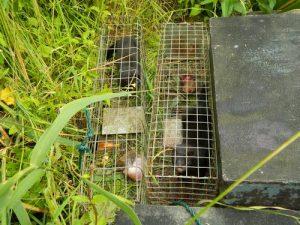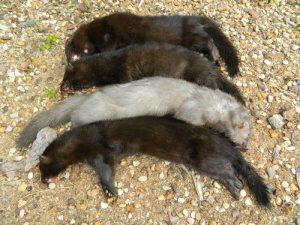Mink Trapping – Steve Caple

I was recently approached by a local marina owner and asked to remove a family of mink that had taken up residence amongst the pontoon walkways that ran alongside the moored barges. They had decimated the local moorhen and duck population that regular visitors to the nearby canal-side restaurant had been used to seeing and feeding at the waters edge. I was informed, on arrival, that there had been regular sightings of about four, three-quarter grown kits, that often played beneath the slatted walkways, and that they were getting bolder and more brazen in their antics. I always like to glean as much information from a client as possible before embarking on a trapping programme as this can often make the problem a lot quicker and easier to resolve. Where and when do most sightings occur? Do you know the area they are living in or coming from? These are the first and most obvious questions to ask. Once the areas of most activity have been established then your powers of observation and field-craft will need to come into operation.
It’s no use whatsoever just plonking a cage down anywhere and hoping that a mink will come along find it! You need to pin-point the exact location of the most mink activity; look for fresh scats (droppings) or where they haul themselves out at the waters edge. If you can find a food stash of partly eaten fish, frogs, or waterfowl eggs then so much the better as this will give you a good idea of where to secrete your cages. On this particular job a lot of activity and fresh scats were concentrated at the end of a walkway where it joined a steep bank that was overgrown with vegetation. There was also a well used run beneath the slatted pontoon that exited at the point where it joined the bank, so this was obviously an ideal place to set a cage trap. Contrary to popular belief, mink are not difficult to catch. Like most predators, they very rarely refuse an easily obtained free meal, and this plays right into your hands as a skilled trapper. When dealing with the young of any species they can be foolhardy in the extreme, and none more so than mink. Having set my first cage baited with a chunk of fresh rabbit complete with a little fur, I walked twenty paces along the pontoon to set a cage at the other end. Realizing I had forgotten to pin the first cage down with a T bar, I retraced my steps only to find the cage had already caught its first customer, a hissing dervish of a young mink. Knowing that young kits usually stick close together, I placed a second cage alongside the first, (after dispatching the first catch), and to my amazement, caught two more jet black kits within 15 minutes. This is often a good ploy if dealing with multiple youngsters as often you will find other kits climbing all over a cage containing its trapped sibling. The last of the four mink was caught later the same day, a lovely silver bitch mink that was responsible for producing the youngsters. Not all jobs are as easy and successful as this, but to clear up a major mink problem in a single day, is an unexpected and satisfying result.
Cage trapping mink can be extremely simple at times, as in the example just described, but on other occasions, can be fraught with great difficulty. People differ in their opinions as to the best bait to use when cage trapping mink, and what works extremely well in one area may not be as successful in another. For me, fresh rabbit meat with a little fur is one of the best baits ever, but pigeon breast containing a few loose white feathers, is a close second. Tinned cat food, pilchards, kippers, liver, sardines and fresh fish, are just some of the baits I have used in the past with successful results, but you must decide what works best for you. The most important factor of any trapping exercise is to put your traps or cages where the target species will readily find it. The best laid trap in the world will not catch what is not there. When cage trapping mink at the waterside it is important to secure or anchor your cages in some way to prevent them becoming dislodged and falling into the water. This can be done by pushing a T bar through the cage and pinning it tight to the ground, or by tethering it to a post or a nearby immovable object. In some areas, should heavy rain fall over night, the gentle babbling brook where you secreted your mink cages can become a raging torrent of foaming water several metres deep in a matter of hours. If this happens, and you haven’t secured your cages, then your expensive outlay could have sailed away into the next county.
Another problem with cage trapping mink is human interference. Cages do not need to be covered in anyway if trapping in a secure location, but they do need to be hidden and disguised in some way if they are used in areas of public access. Hidden in bank-side vegetation, cages can be very hard to spot by members of the public who may not share your enthusiasm for pest control and they should remain undisturbed. The problem arises when they contain a very active and vociferous trapped mink. For this reason, frequent checks should be made of the cages, and always at first light before the public are up and about and any occupants humanely dispatched. As pest controllers we have a duty of care to any animal whilst it is under our control and unnecessary stress is to be avoided at all times. Take care when dealing with a trapped mink as they can strike with lightning speed and a carelessly placed finger can be an inviting target, as I once found out to my cost. When choosing a suitable cage for mink trapping, try and go for a larger and more robust type. I like the old double-entry Fenn cages as this makes it easy to place the bait behind the treadle. When placing bait inside the cage, it is sensible to wire it down and to make sure it sits well in from the edges. If the bait is touching the cage sides, a mink will often try and pull the bait from outside the cage instead of going in through the front door.

If for any reason you are unable to place your cages in the exact location you want, for instance, due to the steepness of a bank, or lack of vegetation, then place it as near as you can to the selected spot. You can, by dropping a few spots of rabbit blood, lead a mink up to the entrance of your cage from an area of frequent activity. You can also use a visual stimulant with the same effect, a few tufts of rabbit fur or some loose white pigeon feathers leading up to your cage will have the same result. If, after catching a few mink, you leave the cages un-cleaned and deliciously scented, this will greatly enhance your chances of future catches. On the subject of scent, do not store your mink cages anywhere near your rabbit cages for obvious reasons. No rabbit will ever enter a cage that smells of its mortal enemy. So there you have it, just a few tips and hints that may improve your success with mink cage trapping, and don’t forget to experiment a little with different baits and locations. I have told you some of the methods I use (and I know some people do things completely differently), but at the end of the day, if the results are exactly the same, that’s all that matters.

© Steve Caple